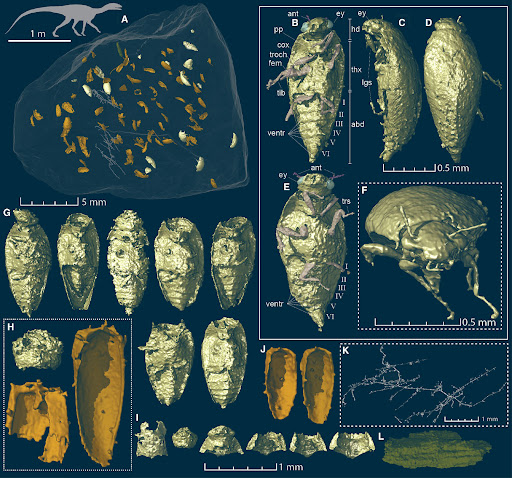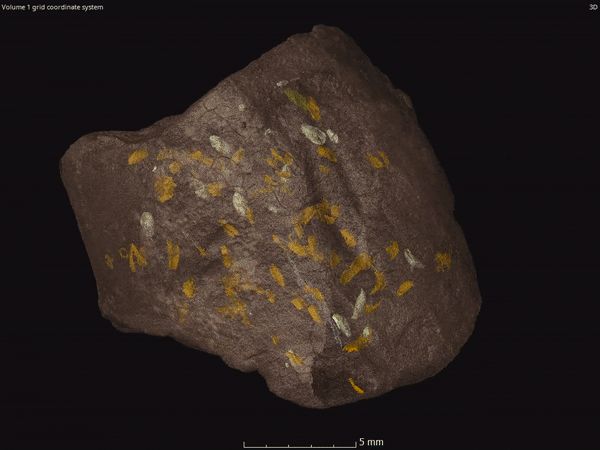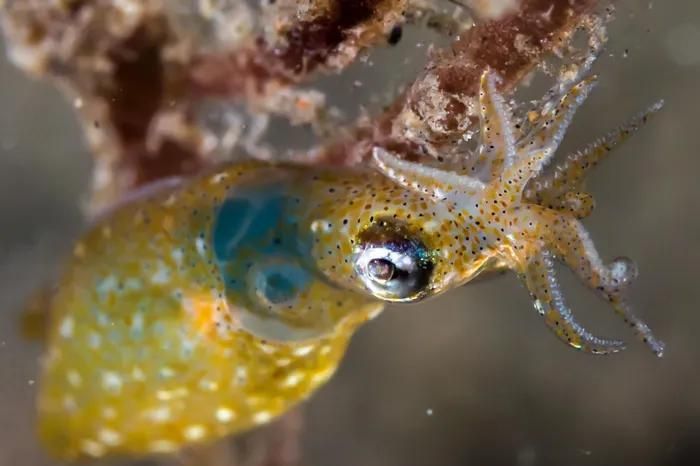Suddenly discovered a completely new species in the dung pile more than 200 million years ago!
About 230 million years ago, a hungry Silesaurus opolensis was feeding in the swamp vegetation of present-day southwestern Poland. Like all vertebrates, like all other animals on our planet, this dinosaur with a height of nearly 1m and a 1m-long tail will excrete what it cannot. absorbed after eating.
Over time, these piles of dung became fossils, and a number of small bugs were embedded in them. These bugs are likened to "ambassadors" of long-extinct insect branches, this is also the first time that humans have discovered a new insect species in dinosaur dung fossils. The discovery was recently published in the journal "Current Biology".

Since ancient times, amber has always been considered the best source of specimens for paleontologists and entomologists to study ancient arthropods. These ants, spiders, and beetles are dipped in tiny bits of golden plastic fossils, as if they were just crawling around. But amber specimens are only about 130 million years old, dating back to the Cretaceous period, while insects from more ancient periods such as the Jurassic and Triassic periods can only be found in the late Cretaceous period. flat rock specimens.
Fossils of animal feces can hold information from ancient times. As Martin Qvarnström, first author of the study and a paleontologist at Uppsala University in Sweden, says, the information provided by fecal fossils is also a fairly "rich but often neglected source of information." ".
Qvarnström says that faecal fossils can not only reveal the species and evolution of faeces to which they belong, but also give paleontologists the opportunity to understand their ecology and eating habits.

Based on the size, shape and other anatomical features, the scientists determined that the fossilized feces contained the newly discovered species of beetle excreted by the dinosaur Silesaurus opolensis. This is a small dinosaur about 2m long, weighs about 15kg and lived in Poland about 230 million years ago during the Triassic period.
Qvarnström and colleagues found a dime-sized fecal fossil in a clay pit near Ozymek (a town in southwestern Poland). Scientists were very interested in the Triassic food web inhabited by Silesaurus opolensis, so they used microsynchrony to document the interior of this opaque fossil.
Among them, X-rays were beamed at the fossil from all directions, clearly showing its internal composition. Putting together the generated image files into a 3D model of the inside of a fecal fossil is a laborious task, but when details about the composition of the feces emerge, suddenly there is a fossil of a species. Ancient bugs appeared in front of Qvarnström.
To identify these insects that may have been swallowed up by Cirisaurus, paleontologists contacted Martin Fikáček, an entomologist at Sun Yat-sen University in Taiwan, China. At first, Fikáček doubted whether the bugs were well preserved.
"There are a lot of fossils that seem to be well-preserved, but we can't confirm which species they are because we can't see all of its features," he explains. But Fikáček soon realized that this specimen was different from all the previous ones. This ancient insect has features that are significantly different from other beetles, such as long antennae and segmented abdomens. "We check each step and do computational analysis. The results always show that this is a completely new clade of extinct insects." And to commemorate its origins, the team named the new species Triamyxa coprolithica, a small aquatic or semi-aquatic beetle that feeds on algae.

Margaret Thayer, Chicago Field Museum's emeritus curator (who was not involved in the study), said: "What the team did with this tiny fecal fossil has left a profound impression on us. This suggests that it is possible that in recent years researchers have also performed imaging analyzes on other fecal fossils, although some of them contain fragments of insects. , but no new species have been found, they are completely different from this study".
Thayer says synctron radiation micro tomography technology allows researchers to see "a lot of detail" without having to see the insect directly. She added that high-resolution imaging technology has "really revolutionized our ability to study previously difficult specimens", such as the triassic scarab in dinosaur droppings. She points out that before the technology came along, "we didn't even know that they were specimens."

This newly discovered species of beetle belongs to the suborder Myxophaga, which often lives in colonies in humid environments. Fikáček was pleased to see that such ancient specimens were very similar to living members of the subspecies Phycophagous. "These bugs were small in size, and very numerous at the time," he said. The cause of their extinction is still unclear, but Thayer said: "In a sense, evolution is a large-scale experiment. Some species have succeeded, some species have not."
Both Qvarnström and Fikáček say that among the many fecal fossils that paleontologists have found dating from the Triassic period or even earlier, there may be more secrets about insect evolution. . They hope this discovery will inspire others to use imaging technology to look inside these fossils and fecal fossils unearthed in the future.
You should read it
- The mystery so far has not been answered: A mountain village has not had a mosquito daring in the last 100 years.
- Stunned to find an ancient 3000-year-old cheese cooking pot
- The Amazon River has a life expectancy of at least 9 million years
- Tracing the stolen truck, discovering the second-century ancient coffin under the olive tree
- Many thousands of years old stone artifacts were found in the North Iran cemetery
- Just because he wanted to hack the game, my brother was infected with cryptocurrency mining malware and ruined his laptop like this
- How to turn on two-factor authentication on Slack
- 6 things you never knew about dragonflies
May be interested
- Crying with 10 giant python species in the world
 over millions of years of survival, many snakes have grown into giants to suit natural habitats. here are 10 giant python species in the world, their size and weight surprised many people.
over millions of years of survival, many snakes have grown into giants to suit natural habitats. here are 10 giant python species in the world, their size and weight surprised many people. - Memory loss for 30 years, suddenly completely recovered when viewing news reports about COVID-19
 a chinese immigrant worker who lost his memory in 1990 suddenly recalled his homeland after watching a news report of the corona virus outbreak.
a chinese immigrant worker who lost his memory in 1990 suddenly recalled his homeland after watching a news report of the corona virus outbreak. - Tooth turtles can last more than 100 million years ago
 a new archaeological finding suggests that tortoises can last more than 100 million years ago a few dozen million years more than what was previously identified.
a new archaeological finding suggests that tortoises can last more than 100 million years ago a few dozen million years more than what was previously identified. - The ancient demon toad with 2,200 newton biting force, kills the dinosaur with a bite
 68 million years ago, on our planet there existed a great species of ancient toad with a strong bite that could eat even small dinosaurs.
68 million years ago, on our planet there existed a great species of ancient toad with a strong bite that could eat even small dinosaurs. - Deciphering the mysterious 5,000-year-old city was completely destroyed in just 1 night
 in 1922, archaeologists discovered an immensely rich, ancient city that existed 5,000 years ago in the indian living basin. but the strange thing is that this city suddenly disappeared within a day. what terrible thing happened to this ancient city?
in 1922, archaeologists discovered an immensely rich, ancient city that existed 5,000 years ago in the indian living basin. but the strange thing is that this city suddenly disappeared within a day. what terrible thing happened to this ancient city? - Jade snake snake - Beauty queen snake in Vietnam
 scientists have discovered more than 200 species of snakes with 22 species of sea snakes, 184 species of land snakes in vietnam. in the kingdom of snakes in our country, jade fences are dubbed the beauty queen with colorful colors and patterns.
scientists have discovered more than 200 species of snakes with 22 species of sea snakes, 184 species of land snakes in vietnam. in the kingdom of snakes in our country, jade fences are dubbed the beauty queen with colorful colors and patterns. - What happens if obnoxious mosquitoes disappear completely on Earth?
 mosquitoes, small but extremely dangerous, are the cause of malaria infection, killing 247 million people worldwide each year. so, if this dangerous creature disappears completely on earth, what will happen, will there be serious consequences like other creatures?
mosquitoes, small but extremely dangerous, are the cause of malaria infection, killing 247 million people worldwide each year. so, if this dangerous creature disappears completely on earth, what will happen, will there be serious consequences like other creatures? - Scientists have discovered 3 new species of snow leopard
 an international team of scientists conducted an unexposed survey to collect dna and arrange panthera uncia's snow leopard genome. this is a carnivorous species that is difficult to detect, hunt and originate from the mountains of central and south asia.
an international team of scientists conducted an unexposed survey to collect dna and arrange panthera uncia's snow leopard genome. this is a carnivorous species that is difficult to detect, hunt and originate from the mountains of central and south asia. - Unique new species of squid, super small 1cm, hunts by sitting still
 scientists have discovered two new species of dwarf squid, only about 1cm in size, living on coral reefs in japan.
scientists have discovered two new species of dwarf squid, only about 1cm in size, living on coral reefs in japan. - Seven new species of spiders were discovered, named after Harry Potter, the GoT character
 seven new spider species discovered by scientists from instituto butantan, sao paulo in brazil have been named after characters from cult literary works like harry potter and game of thrones.
seven new spider species discovered by scientists from instituto butantan, sao paulo in brazil have been named after characters from cult literary works like harry potter and game of thrones.










 Scientists have discovered a new ability of the elephant trunk
Scientists have discovered a new ability of the elephant trunk How many languages are there in the world?
How many languages are there in the world? Ophiojura - 8-legged starfish full of long, snake-like spines, 8 sets of jaws with sharp teeth
Ophiojura - 8-legged starfish full of long, snake-like spines, 8 sets of jaws with sharp teeth Octopuses are very intelligent, they can become candidates for the position of 'ruling the Earth' when humans are no more.
Octopuses are very intelligent, they can become candidates for the position of 'ruling the Earth' when humans are no more. 10 sounds that make people feel the most uncomfortable
10 sounds that make people feel the most uncomfortable Discovered a potential glacier near the surface of Mars, suitable as a base for future astronauts
Discovered a potential glacier near the surface of Mars, suitable as a base for future astronauts